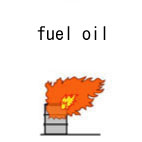| Case Name |
Fire of a fuel oil fraction during sampling at a vacuum distillation unit |
| Pictograph |

|
| Date |
February 29, 1996 |
| Place |
Yokkaichi, Mie, Japan |
| Location |
Refinery |
| Overview |
At a vacuum distillation unit during routine operation, sampling valves of the fuel oil fraction were opened for scheduled sampling. Only a small amount of samples flowed out. Therefore, the valves were opened carelessly, the fuel oil fraction flowed out suddenly, ignited spontaneously, and a fire occurred. A sampling cooler was not used although the temperature of the fuel oil fraction at the sampling point was above the auto-ignition temperature. Sampling should be done at a low temperature point where spontaneous ignition does not occur. |
| Incident |
At a vacuum distillation unit during routine operation, a fire occurred during sampling. A valve was opened for scheduled sampling of a fuel oil fraction. As only a small quantity of sample oil flowed out, the valve was adjusted. Suddenly, fuel oil fractions flowed out rapidly, and it overflowed the sampling pit. As the oil temperature was 300 °C or more, it ignited spontaneously and a fire occurred. |
| Processing |
Manufacture |
| Individual Process |
Distillation |
| Process Flow |
Fig2.Unit process flow
|
| Substance |
Fuel oil |
| Type of Accident |
Leakage, fire |
| Sequence |
07:30 on February 29th, 1996. Scheduled sampling of a fuel oil fraction was started by nine operators at a vacuum distillation unit during routine operation. Although two operators opened the valve for sampling, a sample did not flow out. For this reason, two valves were adjusted. Suddenly, about 200 L of fuel oil fractions flowed out of from the valve, and overflowed the sampling pit.
About 7:53. It ignited spontaneously and a fire occurred. Three fire engines and six fire fighters turned out.
7:58. The fire department was notified about the fire. Ten fire engines and 58 fire fighters turned out.
8:09. It was confirmed that the fire had been extinguished. |
| Cause |
Purging at the time of previous sampling was imperfect, and solidification occurred in piping. As the quantity of samples that flowed out was very small, the valves were opened carelessly. The valves could not be immediately closed when the outflow began. Warm water was not poured onto the cooling device, so it resulted in ignition. |
| Response |
Fire extinguishing by a large fire extinguisher and PPT fixed firefighting equipment. |
| Countermeasures |
Cooling devices should be installed when the temperature of samples is higher than the auto-ignition temperature, or the sampling point should be moved to a low-temperature point.
Work standards should clarify measures against plugging in sampling piping.
Safety education, such as "point to the object, call its name or status" and observance of work standards, should be strengthened. |
| Knowledge Comment |
The cause, by which only a small amount of samples flowed out when the sampling valve was opened, is not only breakage or blockage of the valve, but also blockage of sampling piping in many cases.
There might be a flammable liquid with a temperature above a spontaneous ignition temperature in piping and a reactor. If it leaks, it will ignite immediately.
In principle, sampling should be done at a point where pressure and temperature are as low as possible. |
| Background |
Although there was a defect in the facilities, the cause of the fire was clearly human error. A cooling device was not used for sampling at a temperature higher than the auto-ignition temperature. Moreover, there was human error because the valve was opened fully although it was prohibited. It is assumed that inadequate purging after the last sampling was also a deviation from the work standard.
Prior directions and cautions of a management superintendent were not given for low frequency work. Sampling in the facilities should have been done downstream from the distillate oil cooler where the sampling oil temperature was low. |
| Incidental Discussion |
This is also a problem of dead-end piping. Even if it is at a high temperature during sampling, the temperature falls to room temperature. Solidification in sampling piping is natural, so why was purging inadequate? |
| Reason for Adding to DB |
Example of fire caused due to deviation from work standards for sampling |
| Scenario |
| Primary Scenario
|
Organizational Problems, Inflexible Management Structure, Insufficient Education/Training, Carelessness, Insufficient Understanding, Insufficient Recognition of Risk, Poor Value Perception, Poor Safety Awareness, Insufficient Safety Measure, Malicious Act, Rule Violation, Neglect of Indication, Bad Event, Chemical Phenomenon, Melting, Secondary Damage, External Damage, Fire
|
|
| Sources |
Fire and Disaster Management Agency, Fire when sampling fuel oil fraction. Accident cases of dangerous materials. 1996. pp.74-75.
High Pressure Gas Safety Inst. of Japan, The high-pressure gas protection overview. 1997 edition, pp.200-201 (1997).
|
| Physical Damage |
Damage to the floor, an operation stand, motor-driven valves, instrumentation cables, and piping thermal insulation. |
| Financial Cost |
¥ 76,000 (Fire and Disaster Management Agency). |
| Field |
Chemicals and Plants
|
| Author |
ITAGAKI, Haruhiko (Japan National Institute of Occupational Safety and Health)
TAMURA, Masamitsu (Center for Risk Management and Safety Sciences, Yokohama National University)
|
|